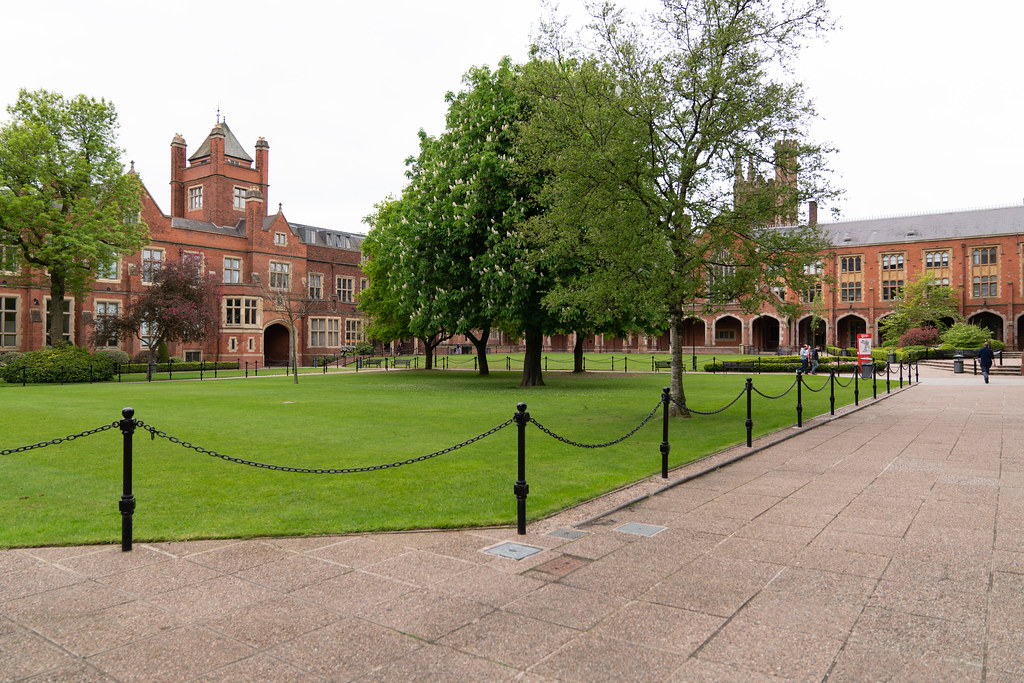QUEEN'S UNIVERSITY
This was my first visit to Belfast that was not impacted by rain but unfortunately when I visited Queen's University the sky was very dark even though there was no actual rain.
Queen's University Belfast has its roots in the Belfast Academical Institution, which was founded in 1810, one of the United Kingdom's 10 oldest universities, and remains as the Royal Belfast Academical Institution. The present university was first chartered as "Queen's College, Belfast" in 1845, when it was associated with the simultaneously founded Queen's College, Cork, and Queen's College, Galway, as part of the Queen's University of Ireland – founded to encourage higher education for Catholics and Presbyterians, as a counterpart to Trinity College, Dublin, then an Anglican institution.
Queen's College, Belfast, opened in 1849. Its main building, the Lanyon Building, was designed by the English architect, Sir Charles Lanyon. At its opening, it had 23 professors and 343 students. Some early students at Queen's University Belfast took University of London examinations.
The Irish Universities Act, 1908 dissolved the Royal University of Ireland, which had replaced the Queen's University of Ireland in 1879, and created two separate universities: the current National University of Ireland and Queen's University of Belfast.
In addition to the main campus on the southern fringes of Belfast city centre, the university has two associated university colleges, St Mary's and Stranmillis located in the west and south-west of the city respectively. These colleges offer teacher training for those who wish to pursue teaching careers and a range of degree courses, all of which are centred around a liberal arts core.
While the university refers to its main site as a campus, the university's buildings are in fact spread over a number of public streets in South Belfast, principally University Road, University Square and Stranmillis Road, with other departments located further afield.
Queen's University Belfast has its roots in the Belfast Academical Institution, which was founded in 1810, one of the United Kingdom's 10 oldest universities, and remains as the Royal Belfast Academical Institution. The present university was first chartered as "Queen's College, Belfast" in 1845, when it was associated with the simultaneously founded Queen's College, Cork, and Queen's College, Galway, as part of the Queen's University of Ireland – founded to encourage higher education for Catholics and Presbyterians, as a counterpart to Trinity College, Dublin, then an Anglican institution.
Queen's College, Belfast, opened in 1849. Its main building, the Lanyon Building, was designed by the English architect, Sir Charles Lanyon. At its opening, it had 23 professors and 343 students. Some early students at Queen's University Belfast took University of London examinations.
The Irish Universities Act, 1908 dissolved the Royal University of Ireland, which had replaced the Queen's University of Ireland in 1879, and created two separate universities: the current National University of Ireland and Queen's University of Belfast.
In addition to the main campus on the southern fringes of Belfast city centre, the university has two associated university colleges, St Mary's and Stranmillis located in the west and south-west of the city respectively. These colleges offer teacher training for those who wish to pursue teaching careers and a range of degree courses, all of which are centred around a liberal arts core.
While the university refers to its main site as a campus, the university's buildings are in fact spread over a number of public streets in South Belfast, principally University Road, University Square and Stranmillis Road, with other departments located further afield.

QUEEN'S UNIVERSITY 001
-

QUEEN'S UNIVERSITY 002
-

QUEEN'S UNIVERSITY 003
-

QUEEN'S UNIVERSITY 004
-

QUEEN'S UNIVERSITY 005
-

QUEEN'S UNIVERSITY 006
-

QUEEN'S UNIVERSITY 007
-

QUEEN'S UNIVERSITY 008
-

QUEEN'S UNIVERSITY 009
-

QUEEN'S UNIVERSITY 010
-

QUEEN'S UNIVERSITY 011
-

QUEEN'S UNIVERSITY 012
-

QUEEN'S UNIVERSITY 013
-

QUEEN'S UNIVERSITY 014
-

QUEEN'S UNIVERSITY 015
-

QUEEN'S UNIVERSITY 016
-

QUEEN'S UNIVERSITY 017
You will find links to buy products from Amazon, Google and other partners. If you click on these links, you’ll find that the URL includes a small extra piece of text which identifies that the click came from my websites. This text is an affiliate code, and it means that I get a small percentage of the money you spend if you choose to buy that product, or, in some cases, other products from the site soon after. These affiliate links help pay the costs of producing my websites and ensure that the content is free to you.















